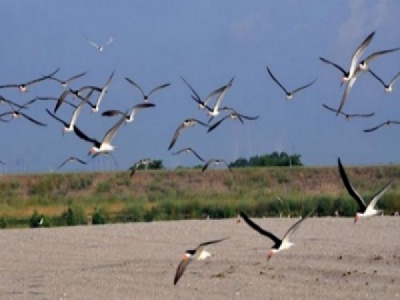
Posted on February 2, 2017
By Mary Landers, savannahnow.com
A key mitigation feature of the $706 million Savannah harbor deepening project is being revised with a plan that employs scarecrows and drones to keep birds off a potentially hazardous site. The U.S. Army Corps of Engineers released its new plan recently for disposing of cadmium-laden sediment dredged from the bottom of the river last month.
The corps had previously planned to dispose of the heavy metal-laden sediment on two spoils area on the river across from Elba Island. They were going to do so by filling the area with enough water to float a barge to isolate and place the sediments before covering them with a two-foot layer of clean sediments.
But a closer look at the situation indicated that was a no-go.
“The analysis revealed that the containment dikes would exhibit severe stability issues and likely fail during placement of water to create the ponded area,” the supplemental report reads.
Cadmium occurs naturally in some soils deep under the river. Lab testing indicated that adverse impacts to birds were likely from normal placement of those sediments into the disposal areas. Corps officials will monitor impacts before, during and after the deepening.
The new plan calls for just enough water to keep the sediments moist. Wet sediments are safer for birds and other wildlife. That’s because the cadmium becomes more mobile in dry sediments, potentially leading to adverse environmental impacts even at lower concentrations of the metal.
To further safeguard wildlife, the new plan lists both old-fashioned and newfangled ways to keep birds off. They include the “use of scarecrows, streamers, fake owls, giant eyes, live raptors, or other visual bird deterrents” plus “a person riding an ATV around the placement site on a daily basis during daylight hours using all appropriate means to prevent birds from feeding and nesting in the placement area.”
It also suggests evaluating the use of a drone to harass the birds over a larger area.
The corps has also revised downward from 11.7 million cubic yards to 4.4 million cubic yards the volume of cadmium laden sediments it expects to handle. The reduction is due in part to the fact that the river is being dredged to 47 feet deep rather than to the 48 foot depth on which the original estimate was made.
“The deeper borings were where the cadmium was mixed in,” said Nathan Dayan, the environmental team leader in the Savannah corps’ planning section. “Some fell out because it’s not touching the cadmium any more.”
The reduction means only one of the two adjacent containment areas will likely be needed for sediment. Effluent from the first site will pass through the second, if needed. These areas are also the site of the proposed Jasper Port. If the port is built, a layer of concrete over the site will further encapsulate the cadmium, keeping it away from wildlife, Dayan said, emphasizing that it’s not a concern for human health at the levels detected.
Public comment is open until Feb. 3. The Savannah Riverkeeper will be commenting on the plan, said Riverkeeper Tonya Bonitatibus. Neither Georgia nor South Carolina imposes a water quality standard for cadmium even though it’s a heavy metal that could be harmful if it made its way into the food chain, she said. The harbor deepening plan addresses cadmium disposal as a result of a 2013 settlement agreement reached with the Riverkeeper and other groups to safeguard the river.
“The changes better not result in more cadmium getting in the river than is allowed in the settlement agreement,” Bonitatibus said.
Source: savannahnow





